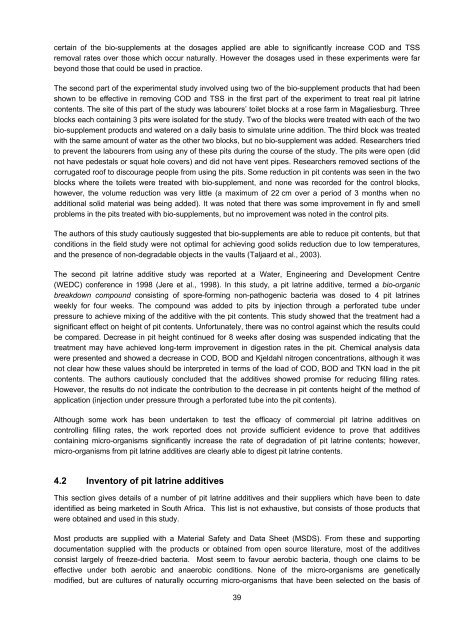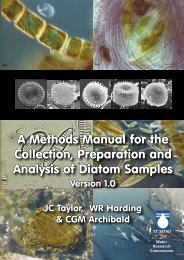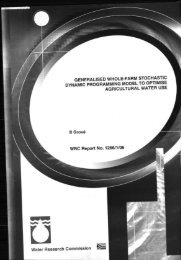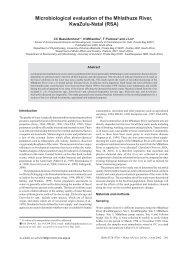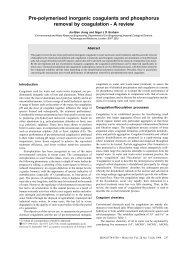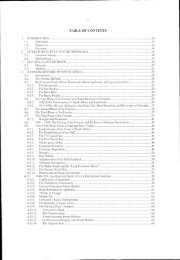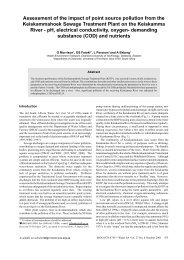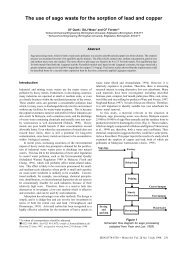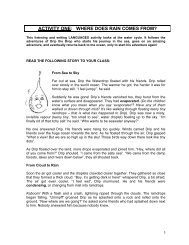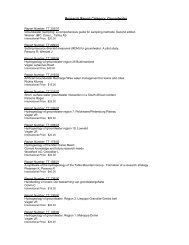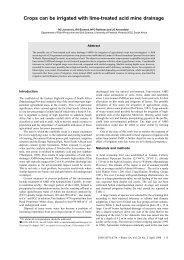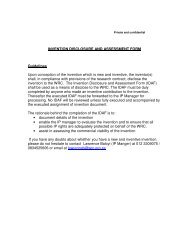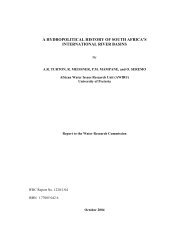and the Efficacy of Pit Latrine Additives - Water Research Commission
and the Efficacy of Pit Latrine Additives - Water Research Commission
and the Efficacy of Pit Latrine Additives - Water Research Commission
- No tags were found...
You also want an ePaper? Increase the reach of your titles
YUMPU automatically turns print PDFs into web optimized ePapers that Google loves.
certain <strong>of</strong> <strong>the</strong> bio-supplements at <strong>the</strong> dosages applied are able to significantly increase COD <strong>and</strong> TSS<br />
removal rates over those which occur naturally. However <strong>the</strong> dosages used in <strong>the</strong>se experiments were far<br />
beyond those that could be used in practice.<br />
The second part <strong>of</strong> <strong>the</strong> experimental study involved using two <strong>of</strong> <strong>the</strong> bio-supplement products that had been<br />
shown to be effective in removing COD <strong>and</strong> TSS in <strong>the</strong> first part <strong>of</strong> <strong>the</strong> experiment to treat real pit latrine<br />
contents. The site <strong>of</strong> this part <strong>of</strong> <strong>the</strong> study was labourers’ toilet blocks at a rose farm in Magaliesburg. Three<br />
blocks each containing 3 pits were isolated for <strong>the</strong> study. Two <strong>of</strong> <strong>the</strong> blocks were treated with each <strong>of</strong> <strong>the</strong> two<br />
bio-supplement products <strong>and</strong> watered on a daily basis to simulate urine addition. The third block was treated<br />
with <strong>the</strong> same amount <strong>of</strong> water as <strong>the</strong> o<strong>the</strong>r two blocks, but no bio-supplement was added. <strong>Research</strong>ers tried<br />
to prevent <strong>the</strong> labourers from using any <strong>of</strong> <strong>the</strong>se pits during <strong>the</strong> course <strong>of</strong> <strong>the</strong> study. The pits were open (did<br />
not have pedestals or squat hole covers) <strong>and</strong> did not have vent pipes. <strong>Research</strong>ers removed sections <strong>of</strong> <strong>the</strong><br />
corrugated ro<strong>of</strong> to discourage people from using <strong>the</strong> pits. Some reduction in pit contents was seen in <strong>the</strong> two<br />
blocks where <strong>the</strong> toilets were treated with bio-supplement, <strong>and</strong> none was recorded for <strong>the</strong> control blocks,<br />
however, <strong>the</strong> volume reduction was very little (a maximum <strong>of</strong> 22 cm over a period <strong>of</strong> 3 months when no<br />
additional solid material was being added). It was noted that <strong>the</strong>re was some improvement in fly <strong>and</strong> smell<br />
problems in <strong>the</strong> pits treated with bio-supplements, but no improvement was noted in <strong>the</strong> control pits.<br />
The authors <strong>of</strong> this study cautiously suggested that bio-supplements are able to reduce pit contents, but that<br />
conditions in <strong>the</strong> field study were not optimal for achieving good solids reduction due to low temperatures,<br />
<strong>and</strong> <strong>the</strong> presence <strong>of</strong> non-degradable objects in <strong>the</strong> vaults (Taljaard et al., 2003).<br />
The second pit latrine additive study was reported at a <strong>Water</strong>, Engineering <strong>and</strong> Development Centre<br />
(WEDC) conference in 1998 (Jere et al., 1998). In this study, a pit latrine additive, termed a bio-organic<br />
breakdown compound consisting <strong>of</strong> spore-forming non-pathogenic bacteria was dosed to 4 pit latrines<br />
weekly for four weeks. The compound was added to pits by injection through a perforated tube under<br />
pressure to achieve mixing <strong>of</strong> <strong>the</strong> additive with <strong>the</strong> pit contents. This study showed that <strong>the</strong> treatment had a<br />
significant effect on height <strong>of</strong> pit contents. Unfortunately, <strong>the</strong>re was no control against which <strong>the</strong> results could<br />
be compared. Decrease in pit height continued for 8 weeks after dosing was suspended indicating that <strong>the</strong><br />
treatment may have achieved long-term improvement in digestion rates in <strong>the</strong> pit. Chemical analysis data<br />
were presented <strong>and</strong> showed a decrease in COD, BOD <strong>and</strong> Kjeldahl nitrogen concentrations, although it was<br />
not clear how <strong>the</strong>se values should be interpreted in terms <strong>of</strong> <strong>the</strong> load <strong>of</strong> COD, BOD <strong>and</strong> TKN load in <strong>the</strong> pit<br />
contents. The authors cautiously concluded that <strong>the</strong> additives showed promise for reducing filling rates.<br />
However, <strong>the</strong> results do not indicate <strong>the</strong> contribution to <strong>the</strong> decrease in pit contents height <strong>of</strong> <strong>the</strong> method <strong>of</strong><br />
application (injection under pressure through a perforated tube into <strong>the</strong> pit contents).<br />
Although some work has been undertaken to test <strong>the</strong> efficacy <strong>of</strong> commercial pit latrine additives on<br />
controlling filling rates, <strong>the</strong> work reported does not provide sufficient evidence to prove that additives<br />
containing micro-organisms significantly increase <strong>the</strong> rate <strong>of</strong> degradation <strong>of</strong> pit latrine contents; however,<br />
micro-organisms from pit latrine additives are clearly able to digest pit latrine contents.<br />
4.2 Inventory <strong>of</strong> pit latrine additives<br />
This section gives details <strong>of</strong> a number <strong>of</strong> pit latrine additives <strong>and</strong> <strong>the</strong>ir suppliers which have been to date<br />
identified as being marketed in South Africa. This list is not exhaustive, but consists <strong>of</strong> those products that<br />
were obtained <strong>and</strong> used in this study.<br />
Most products are supplied with a Material Safety <strong>and</strong> Data Sheet (MSDS). From <strong>the</strong>se <strong>and</strong> supporting<br />
documentation supplied with <strong>the</strong> products or obtained from open source literature, most <strong>of</strong> <strong>the</strong> additives<br />
consist largely <strong>of</strong> freeze-dried bacteria. Most seem to favour aerobic bacteria, though one claims to be<br />
effective under both aerobic <strong>and</strong> anaerobic conditions. None <strong>of</strong> <strong>the</strong> micro-organisms are genetically<br />
modified, but are cultures <strong>of</strong> naturally occurring micro-organisms that have been selected on <strong>the</strong> basis <strong>of</strong><br />
39


